Chapter 9 Heredity and Evolution Class 10 Science Important Questions with Answers PDF will help you in scoring more marks. This consists of 1 mark Questions, 3 Mark Numericals Questions, 5 Marks Numerical Questions and previous year questions from Chemical Reactions and Equations Chapter.
Heredity and Evolution Class 10 Important Questions and Answers Science Chapter 9
Very Short Answer Questions
Question 1.
Who proposed the theory of inheritance of acquired characters ?
Answer:
Jean Baptiste Lamarck (1809).
More Resources
- Previous Year Question Papers for CBSE Class 10 Science
- NCERT Solutions for Class 10 Science
- NCERT Exemplar Solutions for Class 10 Science
- Value Based Questions in Science for Class 10
- HOTS Questions for Class 10 Science
Question 2.
Give an example of a vestigial organ present in human body.
Answer:
Vermiform appendix.
Question 3.
Who proposed the theory of natural selection ?
Answer:
Charles Darwin (1859) proposed the theory of natural selection.
Question 4.
In terms of evolution, what is the significance of homology between a human hand and a wing of a bird ?
(CBSE Foreign 2004)
Answer:
Homology indicates that there is common ancestry between a human hand and a wing of a bird. They have the same fundamental structure but are different in external morphology and functions.
Question 5.
Name the scientist who established the laws of inheritance.
Answer:
Gregor Johann Mendel.
Question 6.
Define inheritance.
Answer:
The transmission of characters from parents to offspring is known as inheritance.
Question 7.
What is the function of genes in an organism ?
Answer:
Genes are the carrier of the genetic information for body functions and passage from one generation to another.
Question 8.
What is gene ? (CBSE Delhi 2006 C, 2007, CCE 2014)
Answer:
Gene is a unit of inheritance which consists of a linear segment of chromosome or DNA that takes part in expressing a particular character.
Question 9.
What is speciation ?
Answer:
Speciation: It is the formation of newer species from the pre-existing ones due to accumulation of variations through various processes like isolation, stoppage of gene flow, genetic drift, and natural selection that lead to inability to interbreed.
Question 10.
List any two factors that could lead to speciation.
Answer:
It is the formation of newer species from the pre-existing ones due to accumulation of variations through various processes like isolation, stoppage of gene flow, genetic drift, and natural selection that lead to inability to interbreed.
Question 11.
What are homologous organs ?
Answer:
Homologous Organs: They are organs which have similar origin, similar development and similar internal structure but have different forms and functions.
Examples: Fore-limbs of Horse, human hand, flipper of whale, wing of bird or bat.
Question 12.
Give the respective scientific terms for studying
- The mechanism by which variations are created and inherited
- The development of new type of organisms from the existing ones.
Answer:
- Genetics,
- Speciation.
Question 13.
Write the contribution of Charles Darwin in the field of ‘evolution’.
Answer:
In 1859, he proposed the “Theory of Natural Selection”.
Question 14.
No two individuals are absolutely alike in a population. Why ?
Answer:
Due to appearance of variations caused by reshuffling of genes, mutations and acquired traits.
Question 15.
Where are genes located ?
Answer:
Genes are located over the chromosomes/DNA as linear segments.
Question 16.
What is heredity ?
Answer:
Heredity: It is the transmission of genetic traits from one generation to the next with the help of genes.
Question 17.
The first trophic level in a food chain is always a green plant. Why ?
Answer:
A food chain as well as an ecosystem is sustained by food energy which is build up only by green plants.
Question 18.
In F1 generation what does F1 stand for ? (CCE 2015)
Answer:
First filial generation (generation of hybrids).
Question 19.
A bacterial cell is different from cells of other organisms. Name the feature which makes it different from others. (CCE 2015)
Answer:
Prokaryotic nature while eukaryotic nature (having organized nucleus) is found in other organisms.
Question 20.
In case of round yellow and green wrinkled, which is dominant trait set ? (CCE 2015)
Answer:
Round yellow.
Short Answer Questions (2 Marks Each)
Question 1.
What are fossils ? How do they tell us about process of evolution ? (CBSE AI. 2008, 2008 C)
Answer:
Fossils: They are remains or impressions of past organisms that lie hurried in the rocks and other structures belonging to various ages.
Fossils Indicate Evolution
- Different types of organisms appeared in different ages. Many of them have later on disappeared. Some gave rise to other organisms while a few are persisting even now.
- Early forms were simple. Most of the later forms became more and more complex.
- Fossils of different ages indicates the path of evolution,

- Some fossils have characteristics intermediate between two groups, e.g., Archaeopteryx between reptiles and birds. They indicate the path of evolution.
- Phylogeny of some organisms has been worked out with the help of fossils e.g., Horse.
Question 2.
Describe briefly four ways in which individuals with a particular trait may increase in population.
(CBSE Foreign 2008)
Answer:
The individuals with a particular trait will increase in number if the trait provides :
- More Food: The trait helps in obtaining more food that leads to increased growth and reproduction.
- Useful Variations: The trait helps the individuals to adapt to environment and achieve greater success in struggle for existence.
- Genetic Drift: It causes genetic fixation of a trait which, therefore, occurs, in whole of the progeny.
- Differential Reproduction: The trait gives extra benefit to the individuals in survival and reproduction.
Question 3.
“Variations that confer an advantage to an individual organism only will survive in a population.” Justify.
(CBSE Delhi 2008 C, CCE 2011)
Answer:
Useful variations give advantage to individuals in obtaining more food, adaptation to environmental changes and higher success in the struggle for existence. They give benefit in survival and reproduction. Differential reproduction increases the useful variations in the populations. Other individuals with harmful variations will be eliminated. For example, some bacteria have ability to tolerate high temperature. In warm environment non-tolerant bacteria will be killed. Others with tolerance to high temperature will survive and multiply.
Question 4.
“The sex of the children are determined by what they inherit from their father and not the mother.” Justify. (CBSE Delhi 2008 C, CCE 2011)
Answer:
Ovum produced by would-be-mother is always of one type (22 + X). Sperms produced by would-be father are of two types, gynosperms (22 + X) and androsperms (22 + Y). If gynosperm (22 + X) fertilizes the ovum (22 + X), the sex of the child will be female (44 + XX). If androsperms (22 + Y) fuses with the ovum (22 + X), the child born will be boy (44 + XY). Therefore, only father is responsible for the sex of the children.
Question 5.
Give one example of each of the characters that are inherited and the ones that are acquired in humans.
Mention the difference between the inherited and the acquired characters. (CBSE 2010)
Answer:
Inherited Trait: Fused and Free ear lobes.
Acquired Trait: Muscular body of a wrestler.
Difference: Acquired trait develops during the life time of an individual which affects somatic parts and dies with the death of the individual. Inherited trait is obtained from the parents, influences genes or germ cells and is passed on to the next generation.
Question 6.
(a) Write foil form of DNA.
(b) Why are variations essential for the species ? (CCE 2011)
Answer:
(a) DNA. Deoxyribose nucleic acid.
(b) Many of the variations have no immediate benefit to the species. They function as preadaptations which can be beneficial under certain environmental conditions like heat tolerance variation if the temperature of the area rises.
Question 7.
How do sexual and asexual reproduction lead to spéciation ? Give one point for each. (CCE 2011)
Answer:
- Sexual reproduction produces a lot of variations due to reshuffling of chromosomes and crossing over.
Variations help in natural selection and spéciation. - Asexual reproduction also develops variations occasionally due to errors in DNA replication. These variations help in natural selection and speciation.
Question 8.
List four tools used to study evolutionary relationships. (CCE 2011)
Answer:
- Study of fundamental and correlated characters.
- Study of homologous organs.
- Study of fossil ancestors.
- Molecular phylogeny.
Question 9.
State the importance of chromosomal difference between sperms and eggs of humans. (CCE 2013)
Answer:
Human eggs are of one type with a chromosomal complement of 22 + X. Human sperms are of two types with chromosomal complements of 22 + X and 22 + Y. Sex of the child will be determined by which sperm type fuses with the egg. Sex of the child will be male if 22 + Y sperm fuses with the egg (22 + Y, 22 + X). It will be female if 22 + X sperm fuses with the ovum (22 + X, 22 + X).
Question 10.
Insects, octopus, planaria and vertebrates possess eyes. Can we group these animals together on the basis of eyes that they possess ? Justify your answer giving reason. (CCE 2014)
Answer:
No. Eyes of the above four types of animals are structurally quite different. They are analogous structures.
Question 11.
In an area A, the leaf material available to beetles was very less. What are the two consequences seen in these beetles ? (CCE 2014)
Answer:
- Average weight of adult beetles decreases,
- There is decrease in the number of beetles.
Question 12.
Explain how do organisms create an exact copy of themselves. (CCE 2014)
Answer:
Organisms create an exact copy of themselves in the form of offspring by passing their genetic traits to them. This is done through propagules in asexual reproduction and gametes in sexual reproduction.
Short Answer Questions (3 Marks Each)
Question 1.
Explain how the sex of the child is determined genetically at the time of conception in human beings.
(CBSE A.I. 2009, CCE 2011, 2012)
Answer:
In human beings sex is determined by a pair of chromosomes called sex chromosomes. Sex complement of a female is XX while that of a male is XY. The complement is formed at the time of fertilization of the ovum by the sperm, i.e. conception. The ovum is always of one type, 22 + X. Sperms are of two types, gynosperms (22 + X) and androsperms (22 + Y). Fusion of an androsperm (22 + Y) with an egg (22 + X) produces a zygote (44 + XY) that will develop into male baby. Fertilization of an ovum (22 + X) with a gynosperm (22 + X) will form a zygote (44 + XX) that grows into a female baby. Sex of the child cannot be changed afterwards by any method. It is determined at the time of conception.
Question 2.
Distinguish between acquired and inherited traits, giving one example of each. Why are the traits acquired during life time of an individual not inherited ? (CBSE A.I. 2009 C, 2014, 2017, Delhi 2016, 2017)
Answer:
Differences between Acquired and Inherited Traits
|
Acquired Traits |
Inherited Traits |
| 1. Development. The traits develop during life time of an individual.
2. Nature. They are somatic variations. 3. Cause. Acquired traits develop due to direct effect of environment, use and disuse and conscious efforts. 4. Fate. They die with the death of the individual. Ex. Muscular body of a wrestler. |
The traits are obtained from the parents.
They are genetic variations. The traits develop due to mutations and reshuffling of genetic material. They are passed on to the next generation. Ex. Fused and free ear lobes. |
(b) Non-inheritance of Acquired Traits: Traits acquired during life time of an individual influence only the non-reproductive organs. There is no influence on the DNA of germ cells. Only the germ cells transfer traits from parents to offspring. Non-reproductive organs have no such role. Traits acquired by them die with the death of the individual.
Question 3.
Name the organism Mendel used for his experiments. Explain about F1 and F2 progeny obtained by Mendel when he bred tall and short varieties of the organism he experimented with.
(CBSE A.I. 2010, CCE 2012)
Answer:
Organism: Garden or Edible Pea (Pisurn sativum).
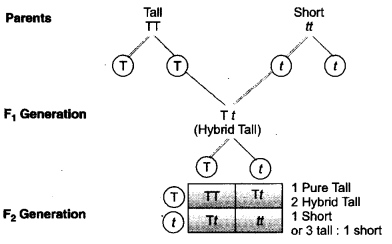
Question 4.
Name two homologous structures in vertebrates. Why are they so called ? How do such organs help in understanding an evolutionary relationship ? (CBSE A.I. 2010)
Answer:
Fore limbs of Horse and Man are homologous structures which have similar origin, similar development and similar internal structure but have different external forms and functions. Homologous structures indicate that similar structures can be modified to perform different functions or undergo evolution.
Question 5.
With the help of a suitable example, explain natural selection. (CBSE Foreign 2010)
Answer:
Natural selection is preferential survival and differential reproduction of individuals of a population which possess variations that provide better adaptability to the existing environment. Peppered Moth of England has two forms, light grey and dark grey. Prior to industrial revolution, tree trunks in the forests around
Manchester were light greyish green due to presence of lichens. Most of the Peppered Moth found in the area were light coloured with dark spots which could not be spotted easily by predator birds. During 1845 to 1890, air pollution killed the lichen flora. The deposition of soot changed the colour of the tree trunks to blackish one. Peppered Moth of the area also exhibited switch over to melanic or blackish form.
It provided better survival value against dark background. The light grey form largely disappeared as it could be easily spotted by predator birds and devoured.
Question 6.
Genotype of a plant bearing purple flowers is PP and one with white flowers is pp. When these are crossed :
(a) What colour of the flowers would you find in F1 progeny ?
(b) Give the percentage of white flowers if F1 plants are self pollinated.
(c) In what ratio would you find PP and Pp in F2 progeny ? Draw flow chart in support of your answer.
(CCE 2011)
Answer:
(a) Purple
(b) 25%
(c) 1:2
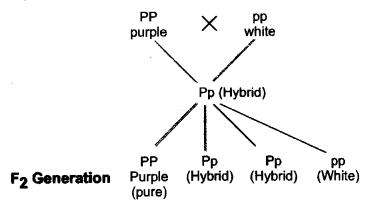
Question 7.
(a) What are fossils ?
(b) Are the wings of a butterfly and wings of a bat analogous organs or homologous organs ? Justify your answer. (CCE 2011)
Answer:
(a) Fossils: Fossils are remains, traces and impressions of the past organisms that are found in rocks and other structures of different ages.
(b) Analogous: Though performing a similar function, the wings of the two are fundamentally different in their origin and structure. Wings of a butterfly are integumentary = outgrowths while they are modified fore-limbs in bat.
Question 8.
(a) In a monohybrid cross of tall Pea plants denoted by TT and short pea plants denoted by tt, Preeti obtained only tall plants (denoted by Tt) in F1 generation. However, in F2 generation she obtained both tall and short plants. Using the above information, explain the law of dominance.
(b) What is genetic drift ? (CCE 2011)
Answer:
(a) Appearance of trait of shortness in F2 generation shows that the trait was present in F1 generation but was not expressed while the trait of tallness expressed itself. The trait which expresses itself in the presence of its contrasting form is called dominant. The other trait which is unable to express its effect in the presence of its contrasting trait is known as recessive.
(b) Genetic Drift: It is random change in gene frequency in small isolated population owing to factors other than natural selection that results in fixation of certain alleles and elimination of some others.
Question 9.
(a) State any two factors that could lead to the rise of a new species.
(b) How do analogous organs provide evidence in favour of evolution ? (CCE 2011)
Answer:
(a) Natural selection/geographical isolation, mutations/genetic drift leading to reproductive isolation.
(b) Analogous organs, though quite different in basic structure and development have been modified or undergone evolution to form similar functional structures, e.g., wings of butterfly (outgrowths of integument) and bird (modification of fore limbs).
Question 10.
(a) Why traits such as intelligence and knowledge connot be passed on to next generation ?
(b) How can we say that birds are closely related to reptiles and have evolved from them ?. (CCE 2011, 2014)
Answer:
(a) Traits like intelligence and knowledge are acquired characters. They do not modify the DNA of germ cells. Therefore, they are not passed on to progeny.
(b) Cleidoic eggs and scales are found in both reptiles and birds, indicating their close relationship. Birds have evolved from reptiles as they have developed completely four-chambered heart (instead of incompletely four-chambered heart of reptiles), a toothless beak, fore-arms modified into wings and covering of feathers (as found in dromaesaurs).
Question 11.
- “Organs or features may be adapted to perform new function during evolution.” Justify this statement by giving an example.
- “Older, body designs are not inefficient”. Give a suitable example in support of this view. (CCE 2011)
Answer:
- Many organs and features have been formed through modification of existing structures. Limbs have been evolved from lobed fins of lung fishes. Wings have evolved from fore limbs in birds and bats. Feathers which became part of wings and body covering in birds had already been developed in dromaesaurs.
- Bacteria continue to live comfortably and competitively in most of the habitats though their body design is very old and very simple as compared to more modern and elaborate body design of aquatic insects or fish. Therefore, older body designs are not inferior or inefficient.
Question 12.
Why are some Pea plants tall and others short in nature ? Explain with reference to role of genes in controlling characteristics. (CCE 2011)
Answer:
Genes control characters through the synthesis of specific proteins. The proteins take part in formation of body structures, enzymes, hormones and other biochemicals. In case of height in Pea, the protein takes part in producing hormone for growth in height. If the protein is working efficiently, more hormone would be produced and Pea plant becomes tall. However, if the protein is less efficient, small quantity of hormone would be formed and the Pea plant will remain short.
Question 13.
Distinguish between analogous organs and homologous organs. Identify the analogous and homologous organs amongst the following : Wings of an insect, wings of a bat, fore-limbs of frog, fore-limbs of human.
(CCE 2011, 2012)
Answer:
Difference:
|
Homologous Organs |
Analogous Organs |
| 1. External Appearance. It is usually different.
2. Function. They generally perform different functions. 3. Basic Plan and Origin. They are similar. 4. Relationships. They occur in related organisms. 5. Evolution. Homologous organs show adaptive radiation or divergent evolution. Example. Forelimbs of Frog, Lizard, Bird and Human. |
It is generally similar.
They have a similar function. They are different. They occur in unrelated organisms. Analogous organs show convergent evolution. Wings of Insects, Bat and Bird. |
Identification:
- Analogous Organs: Wings of an insect and a bat.
- Homologous Organs: Fore-limbs of Frog and Human.
Question 14.
Study the given data and answer the questions that follow :
|
1 |
2 |
3 |
| Parental plants cross fertilized and seed collected | F1 generation offspring | F2 generation offspring after self pollination of F1 hybrid |
| Male Parent-Round Green seeds Female Parent-Wrinkled Yellow seeds | All seeds Round Yellow | 314-Round Yellow, 110-Round Green, 102-Wrinkled Yellow, 32-Wrinkled Green. |
Answer:
- The data indicates that in F1 generation only dominant traits (round seed, yellow seed) are observed while the recessive ones remain unexpressed.
- The genes of the two characters (shape of seed and colour of seed) assort independently, show recombination and give an F2 ratio of 9 (both dominant) : 3 (one dominant) : 3 (second dominant) : 1 (both recessive).
Question 15.
(a) Place the following in correct sequence : Natural selection, migration, new species and gene flow.
(b) Why are wings of Bat and wings of bird called analogous organs ?
(c) Evolution of Cauliflower, Broccoli, Cabbage, Red Cabbage are all from Wild Cabbage. Is this an example of natural selection or artificial selection ? Justify. (CCE 2011)
Answer:
(a) Migration — Gene flow — Natural selection —New species.
(b) Wings of Bat contain long fingers and a covering of patagia or skin folds. Wings of Bird contain reduced fingers and a covering of feathers.
(c) Artificial selection, as the various forms have been created’ by farmers by selectively picking up mutations found in cultivated plants.
Question 16.
(a) Explain giving examples how artificial selection has helped in the formation of newer varieties of Cauliflower/ vegetables.
(b) List the steps involved in the formation of new species.
(c) How different races of human beings belong to the same species. (CCE 2011, 2012)
Answer:
(a) During long history of cultivation of wild cabbage, newer varieties have been formed due to picking up of selected variations by the farmers. It is called artificial selection, e.g., Cabbage (closer leaves), Kale (large leaves), Kohlrabi (swollen stem), Brussel’s Sprout (large axillary buds), Broccoli (immature green flowers), cauliflower (cluster of strile flowers), Red cabbage (cabbage with red leaves).
(b) Steps in Formation of New Species. Separation of a subpopulation (spatial or geographical isolation), Stoppage of gene flow, genetic drift, accumulation of variations, natural selection, reproductive isolation.
(c) Different races of human beings belong to the same species because they can interbreed among themselves and produce fertile offspring.
Question 17.
(a) Explain the terms analogous and homologous organs with examples.
(b) How does homologous organs explain the process of evolution. (CCE 2011)
Answer:
(a) Analogous Organs: They are organs which have similar appearance and function but are quite different in their origin, development and anatomy.
Examples: Wings of Butterfly (integumentary outgrowths) and bird (modified fore-limbs).
Homologous Organs: They are organs which have similar origin, similar development and similar internal structure but have different forms and functions.
Examples: Fore-limbs of Horse, human hand, flipper of whale, wing of bird or bat.
(b) Homologous organs show how structures with similar internal structure and similar origin have been modified or evolved to become different externally for performing different functions like flying in birds, swimming in whale and grasping in humans by fore-limbs.
Question 18.
Explain how Mendel’s experiment shows that traits are inherited independently.
(CCE 2011, CBSE AI. 2016)
Answer:
Mendel performed crosses, e.g., round yellow seeded and wrinkled green seeded pea plants. Fj plants were round yellow seeded (both dominant traits). On self breeding, F2 plants were found to be of four types — round yellow (9), round green (3), wrinkled yellow (3) and wrinkled green (1). Out of these, two types are recombinations (round green, wrinkled yellow) which can develop only if the traits of the two characters assorted independently.
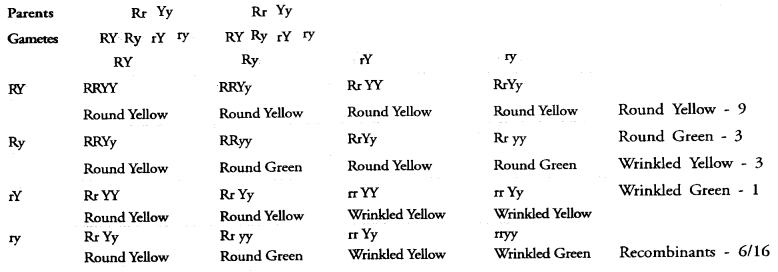
Question 19.
Briefly explain the role of natural selection and genetic drift in spéciation by citing an example.
(CCE 2011, CBSE Foreign 2016)
Answer:
Natural selection is preferential survival and differential reproduction of individuals of a population which possess variations that provide better adaptability to the existing environment. In a beetle population of mostly red colour, a few green beetles appear due to variation. While red beetles are eaten by crows, the green beetles are spared. The number of green beetles will gradually rise while that of red beetles will decline and ultimately disappear. Here, natural selection is being exerted by crows resulting in a new type of beetle population.
Genetic drift is random change in gene frequency in a small isolated population, fixing some alleles and eliminating others. Suppose in the red beetle population some blue beetles appear due to mutation. An elephant tramples the bush and kills all the red beetles. The surviving small population of beetles will be of blue colour though it has no selective advantage.
Question 20.
(a) What is spéciation ? Mention the factors due to which this can happen. (CCE 2012)
(b) Explain whether the traits like eye colour and height are genetically inherited or not.
(c) Do power to lift weight and reading French also belong to same category ? Justify your answer.
(CCE 2 011)
Answer:
(a) Speciation. It is the formation of newer species from the pre-existing ones due to accumulation of variations through various processes like isolation, stoppage of gene flow, genetic drift, and natural selection that lead to inability to interbreed.
(b) Yes. Traits like eye colour and height are genetically inherited. Like other inherited traits they are passed from one generation on to the next and so on.
(c) No. Power to lift weight or read French are acquired characters. They are not passed from one generation to the next.
Question 21.
(a) Write two factors which could lead to rise of new species.
(b)
- What is the scientific term of the organs shown here ?
- How do these organs provide evidence in support of evolution ? (CCE 2011)
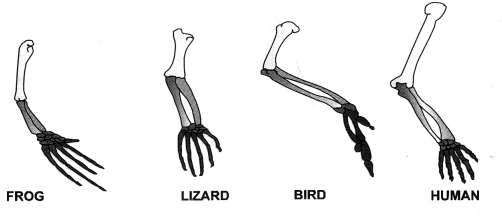
Answer:
(a) Spatial or geographical isolation, accumulation of variations and natural selection.
(b)
- Homologous organs,
- They are fore limbs which have the same basic plan and anatomy but have undergone evolution and become modified to perform different functions.
Question 22.
One plant with dominant tall height bearing purple flowers crossed with another plant with recessive dwarf and white flowers.
(a) What do the plants of F1 generation look like ?
(b) What type of cross is it ?
(c) What is the phenotypic ratio in F2 generation and name the type of plants obtained according to phenotypic ratio. (CCE 2011)
Answer:
(a) All tall and purple flowered
(b) Dihybrid cross,
(c) Nine tall and purple flowered : Three tall and white flowered :Three dwarf and purple flowered : One dwarf and white flowered.
Question 23.
(a) Why a mouse whose tail has been removed by surgery does not produce tailless mice ?
From the set of figures, make a pair of homologous and analogous organs each and give one reason in case of both to justify your answer. (CCE 2011, 2012)
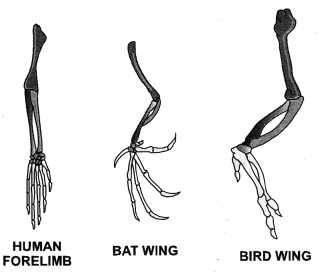
Answer:
Taillessness of mouse is an acquired character. It is not based in genes of germ cells. Therefore, it is not passed on to the next generation.
- Homologous Organs — Fore limb of humans and wing of bird/bat. They have the same body plan being made of humerus, radioulna and hand.
- Analogous Organs — Wing of Bat and wing of bird. In bird the fingers are reduced and the wing is covered by feathers.
Question 24.
In Bat the fingers are elongated and the wing is covered by patagium or fold of skin.
(a) “Recent fossils are found closer to the earth’s surface.” Comment on the statement.
(b) List two factors which could lead to the rise of new species. (CCE 2011)
Answer:
(a) Fossils occur in sedimentary rocks which have been formed through sedimentation of mud and silt at the
bottom of sea and deep lake. Naturally older fossils will lie embedded deep down while the recent fossils would be found in the upper layers near the surface.
(b) Genetic drift, accumulation of variations and natural selection.
Question 25.
(a) Name the sex chromosomes present in human male and human female.
(b) With the help of a flow chart determine genetically in human beings the sex Female Male of the offspring if the sperm carrying X-chromosome fertilizes the egg.(CCE 2011)
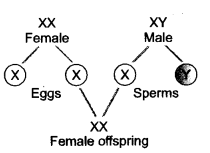
Answer:
(a) Human Male —XY.
Human Female – XX.
(b) Female offspring.
Question 26.
Guinea pig having black colour when crossed with guinea pig having same colour produced 100 offspring, out of which 75 were black and 25 were white. Now find out
(a) What is the possible genotype of the guinea pig ?
(b) Which trait is dominant and which is recessive ?
(c) What is this cross called as and what is the ratio of F2 progeny obtained from this cross ? (CCE 2011)
Answer:
(a) Genotypes —Bb, Bb.
(b) Black colour (B) is dominant while white colour (b) is recessive.
(c) Monohybrid cross: Phenotypic ratio – 3 : 1.
Question 27.
(a) Name an animal which can change sex. What does it indicate ?
(b) Explain the importance of fossils in evolutionary relationship. (CCE 2011)
Answer:
(a) Ophyotrocha — male in young state and female later on. Change is sex indicates that it is not determined genetically.
(b) Significance in Evolution
- Flora and Fauna:. Fossils depict the flora and fauna of different ages. The fossils of early ages were of very simple plants and animals. The fossils of more and more complex plants and animals belong to subsequent times.
- Descent with Modification: Study of fossils shows that plants and animals of one age seem to be descendants of plants and animals of previous age.
- Missing Links: Study of fossils has shown that how birds have developed from reptiles or how seed plants have evolved from ferns.
- Fossils have revealed the evolutionary stages of some organisms,
Question 28.
Give appropriate terms for the following : (a) The trait which can express itself in next generation.
(b) The trait an organism has due to inheritance.
(c) Origin of a new species from pre-existing one. (CCE 2011)
Answer:
(a) Dominant trait.
(b) Inherited trait.
(c) Speciation.
Question 29.
Answer the following questions :
(a) What enables bacteria to survive better in a heat wave ?
(b) How is the stability of DNA of the species ensured ?
Which type of organisms will have more variations, sexually or asexually reproducing organisms ? Justify your answer. (CCE 2011)
Answer:
A pre-adaptation to tolerate higher temperature will enable bacteria to survive better in a heat wave. DNA is stable because of its double stranded nature, semi-conservative replication during reproduction and transcription for cellular activités.
Sexually reproducing organisms show more variations due to reshuffling of chromosomes and crossing over alongwith errors of DNA replication. Very few variations occur in asexually reproducing organisms which are caused by only occasional errors in DNA replication.
Mendel selected Pea Plant for his experiments. List two reasons.
Question 30.
State the meaning of recessive and dominant genes. (CCE 2011)
Answer:
Appearance of dwarf plants in F2 generation indicates that F1 plants contained the traits of both tallness and dwarfness. However, only the trait of tallness expressed itself. The trait which expresses itself in the hybrid is called dominant while the other which is unable to express itself in the presence of dominant trait is called recessive trait.
- Recessive Gene: It is an allele of a gene which is unable to express its effect in the presence of its contrasting allele (e.g., t)
- Dominant Gene: It is an allele of a gene which can express its effect whether present in homozygous or heterozygous state (e.g., T in TT or Tt).
Question 31.
What are fossils ? How are they formed ? Write their one significance. (CCE 2011)
Answer:
(a) Definition: Fossils are remains, traces and impressions of the past organisms that are found in rocks and other structures of different ages.
(b) Formation: Fossil formation or fossilisation occurs in bogs, lava and in sediments at the bottom of deep waters where there is little oxygen and rate of decay is slow or absent. Dead bodies settle down at the bottom which get covered by sand and silt. Under acidic conditions some silica can penetrate cells of dead organism and form perfect fossil. In other cases, softer parts decay ultimately and hard parts persist as fossils. Impressions, moulds and casts develop if all parts decay after some time. The sedimented mud and
sand harden to form sedimentary rock which may come to the surface due to upheavals in earth. This exposes the fossils.
(c) Significance in Evolution
- Flora and Fauna: Fossils depict the flora and fauna of different ages. The fossils of early ages were of very simple plants and animals. The fossils of more and more complex plants and animals belong to subsequent times.
- Descent with Modification: Study of fossils shows that plants and animals of one age seem to be descendants of plants and animals of previous age.
- Missing Links: Study of fossils has shown that how birds have developed from reptiles or how seed plants have evolved from ferns.
- Fossils have revealed the evolutionary stages of some organisms, e.g., Horse.
Question 32.
(a) Define heredity.
(b) Which of the following traits cannot be passed to the progeny ? Justify. (CCE 2011)
- Rudimentary eyes of Planaria.
- Absence of tail in a mouse (after surgical removal).
- Low weight of starving beetle.
(c) Name the vegetables that have been obtained from wild cabbage by artificial selection when farmers opted for
- Arrested flower development of wild cabbage
- Swollen parts of wild cabbage. (CCE 2011)
Answer:
(a) Heredity: It is the transmission of genetic traits from one generation to the next with the help of genes.
(b)
- Rudimentary Eyes of Planaria. Transmitted to next generation as it is a genetic trait.
- Absence of Tail in Mouse. It is an acquired character and is not passed to progeny due to absence of connection to genes of germ cells,
- Low weight of Starving Beetle. Acquired character which cannot pass to the next generation.
(c)
- Arrested Flower Development. Cauliflower
- Swollen Parts. Kohlrabi.
Question 33.
(a) Name the scientist who gave the idea of evolution of species by natural selection
(b) What conclusion did Mendel draw from his experiments about traits ?
(c) Arrange the following according to evolution : Cockroach, Mango Tree, Gorilla, Fish. (CCE 2011)
Answer:
(a) Charles Darwin (1859)
(b) Unit characters, Paired factors, Dominance, Principle or law of segregation (purity of gametes). Principle or law of independent assortment.
(c)
- — Mango Tree —
- Cockroach —> Fish —> Gorilla.
Question 34.
State how evolutionary relationships can be traced by the study of homologous organs. (CCE 2011)
Answer:
Homologous organs have similar internal body plan and anatomy. Fore limbs of all tetrapods have pentadactyl structure being made of humerus, radioulna, carpals, metacarpals and phalanges. However, they perform different functions in different tetrapods like absorbing shock of jumping in Frog, creeping in lizard, flying in birds or grasping in humans. These organs clearly indicate a common ancestry from which different modifications occurred that suited them in their habitats.
Question 35.
Fill in the blanks.
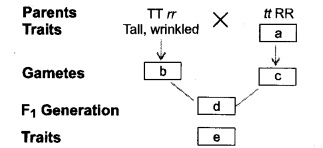
Answer:
(a) — await round
(b) —Tr.
(c) — tR
(d) — TtRr.
(e) — tall round.
Question 36.
(a) Giving reasons, state whether the following are homologous or analogous organs :
- Wing of a bat and wing of a bird.
- Fore limbs of human and bird.
(b) Define variation. (CCE 2012)
Answer:
(a)
- Wing of Bat and Wing of Bird. They are analogous. Wing of bat has long digits and a fold of skin called patagium. Wing of bird has reduced digits and is covered by feathers.
- Fore Limb of Human and Bird. They are homologous as they have a similar origin and similar internal structure or body plan (humerus, radio-ulna, hand).
(b) Variation: It is the difference in morphology, physiology and other traits that occurs amongst individuals of the same parentage, breed, race and species.
Question 37.
In a cross between plants with purple flowers and plants with white flowers, the offspring of F1 generation had all white flowers. When F1 generation individuals were self-bred, the F1 generation gave rise to 100 individuals, 75 of which had white flowers. Make a cross and answer the following :
(a) What are the genotypes of F2 individuals ?
(b) What is the ratio of white to purple flowered plants in F2 generation ?
Answer:
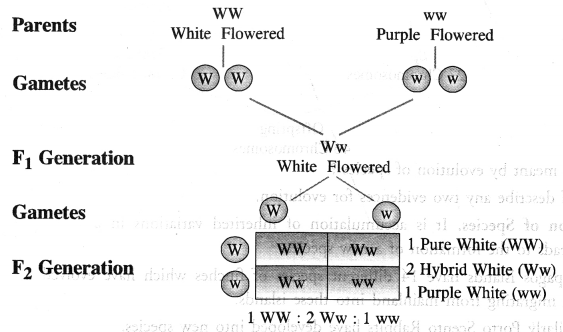
(a) Genotype of F2 Progeny: 1WW : 2Ww : 1 ww
(b) Ratio: 3 white : 1 purple.
Question 38.
(a) Explain geographical isolation.
(b) State with reasons whether the following are homologous or analogous organs :
- Wings of butterfly and wings of a bat.
- Fore limbs of frog and human. (CCE 2012)
Answer:
(a) Geographical Isolation: Prevention of mating between breeding groups due to geographical or physical barriers (e.g., Valley, Mountain, Water body) is called geographical isolation. The isolated populations develop different variations and changes in physiology and behaviour to form new species.
(b)
- Wings of butterfly are integumentary outgrowths while wings of bat are modified fore limbs. The two are analogous structures.
- Fore limbs of frog and human are homologous structures as both have the same body plan and internal structure which in frog are modified to absorb shock during fall on ground while in human they take part in grasping.
Question 39.
Look at the picture and write its name after identifying it. Also give its significance (two points)
(CCE 2012)
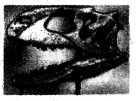
Answer:
(a) Fossil dinosaur skull (Rajasaurus).
(b) Significance:
- The fossil indicates that different types of organisms lived in different periods on earth.
- The study of fossils indicates that organisms of one age are descendents of organisms of previous age.
Question 40.
A husband has 46 chromosomes. His wife has 46 chromosomes. Then why do not their offspring has 46 pairs of chromosomes which is obtained by the fusion of male and female gametes ? Support your answer with a neat illustration. (CCE 2012)
Answer:
Gametes do not possess the same number of chromosomes as are present in individuals. Meiosis occurs prior to formation of gametes. This reduces the number of chromosomes to one half in gametes. In humans, the gametes carry only 23 chromosomes (one half of 46). Fusion of two gametes restores the number of 46 chromosomes in the zygote. Therefore, the human offspring does not have 46 pairs of chromosomes.
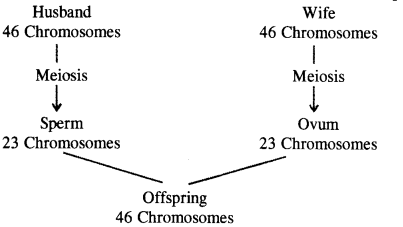
Question 41.
(a) What is meant by evolution of species ?
(b) List and describe any two evidences for evolution. (CCE 2012)
Answer:
(a) Evolution of Species. It is accumulation of inherited variations in a section of existing species that ultimately leads to the formation of a new species.
(b)
- Galapagos islands have 14 different species of finches which have evolved from a small population of birds migrating from mainland into these islands.
- Similarly Porto Scento Rabbits have developed into new species.
Question 42.
“It is a matter of chance whether a couple will give birth to a boy or a girl.” Justify the statement and support your answer with a neat illustration. (CCE 2012, 2014)
Answer:
Mother produces only one type of eggs, 22 + X. Father produces two types of sperms, gynosperms 23 + X and androsperms 22 + Y. The two are produced in equal proportion. It is a matter of chance that an androsperm (22 + Y) or gynosperm (22 + X) first reaches the egg (22 + X) and fuses with it to form a male or female offspring.
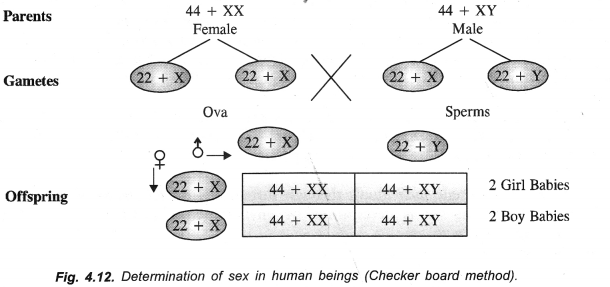
Question 43.
(a) “Our teeth and an elephant’s tusks are homologous organs”. Justify this statement.
(b) What do the analogous organs indicate ? (CCE 2012)
Answer:
(a) Elephants tusks are modified incisor teeth which are used for digging, fighting and tearing bark from trees. For this they come out of mouth. Human teeth remain inside the mouth. Human incisors are used for biting. Since, the two types of teeth have the similar origin and composition they are homologous in nature which perform different functions.
(b) Analogous organs are structurally different organs which have been modified to appear similar and perform similar function, e.g., wings of insects and wings of birds.
Question 44.
“Red beetles live in bush with green beetles. Eventually, the number of green beetles increases as compared to red beetles.”
(a) Give reason for this increased number of green beetles.
(b) State two advantages of variations. (CCE 2012)
Answer:
(a) Red beetles arc quite conspicuous in green bushes. They are picked up by crows for feeding. Green beetles are not easily distinguishable from green leaves of bushes. Therefore, they are not devoured by crows. Population of green beetles will, therefore, increase while that of red beetles will decrease.
(b) Advantages of Variations,
- Variations function as preadaptations to help the organisms to survive in adverse conditions.
- They help individuals in struggle for existence and natural selection.
Question 45.
(a) Define inherited traits.
(b) “Inherited traits are capable of directing evolution”. Justify the statement and support your answer by giving two reasons. > (CCE 2012)
Answer:
(a) Inherited Traits: They are genetically controlled traits which are passed from parents to offspring,
generation after generation.
(b) Evolution: Since, genetic material or genes have a tendency to mutate and form alleles, a number of inherited or genetically controlled variations occur in the traits. The variations which are useful in a given environment are helpful to the individuals to survive and reproduce resulting in natural selection. For example, feather covered fore limbs helped some early dinosaurs to glide and then fly. The forelimbs also got modified to suit this flight. This resulted in evolution of wings as are found in birds.
Question 46.
Name two homologous structures in vertebrates. Why are they so called ? How these organs help in understanding an evolutionary relationship ? (CCE 2012)
Answer:
Paddle of whale and wing of a bird are two homologous organs which have similar basic plan and internal structure. They are externally quite dissimilar and perform different functions, swimming in whale and flying in bird. Their similar internal structure points to their common ancestry. Modification or evolution occurred in them to produce present forms.
Question 47.
(a) Define fossil.
(b) Identify this fossil of invertebrate from this diagram and write its name.
(c) What evidence does it provide in favour of evolution ? (CCE 2012)
Answer:
(a) Fossil: It is remains, trace or impression of a past organism that occurs in the rocks of older ages.
(b) Ammonite, a cephalopod mollusc that occurred on earth some 200 million years ago and underwent mass extinction
Why do traits of thin and low body weight not inherited to the next generation. Answer in detail along with dinosaurs.
(c) Evidence for Evolution: Different types of organisms appeared on earth, flourished and then disappeard leaving their modified descendants and relatives to repeat the process.
It is evolution or descent with change.
Question 48.
Study the given diagram and answer the following question : (CCE 2012)
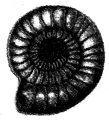

Answer:
Due to lesser availability of nourishment, beetles of second generation remain small and thin. However, it is not an inherited trait but an acquired character. The acquired character is not transferred to the progeny. The progeny (third generation) developed into normal weight and size individuals when food became plenty.
Question 49.
A round seeded plant (RR) is crossed with a wrinkled seeded plant (rr). Find out the phenotype and genotype of F1 and F2 generations. (CCE 2012)
Answer:
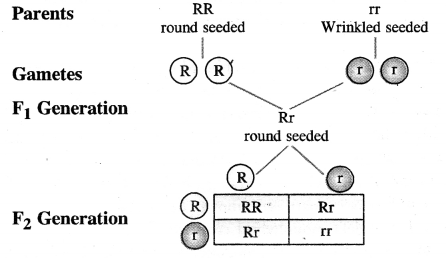
Phenotypic Ratio : 3 round seeded : 1 wrinkled seeded.
Genotypic Ratio : 1 pure round seeded (RR) : 2 hybrid round seeded (Rr). 1 wrinkled seeded (rr).
Question 50.
Define the following with one example of each
(a) Genetic drift
(b) Natural selection
(c) Reproductive isola-tion. (CCE 2012)
Answer:
(a) Genetic Drift: It is random change in gene frequency in small isolated population, fixing some alleles and eliminating others. Suppose in a population of red coloured beetles, some blue coloured beetles appear due to mutation. If all the red coloured beetles are eliminated due to trampling by an elephant, the surving beetles will be all of blue colour, though blue colour has no selective advantage.
(b) Natural Selection: It is survival and preferential reproduction by those individuals which show better adaptation to existing environment. In a population of red and green beedes, crows eat more of red beedes. Green beedes are spared due to their colour which is of adaptive advantage against the background of green foliage.
(c) Reproductive Isolation: It is absence of interbreeding between members of different species. Reproductive
isolation maintains the sanctity of a species. It is also basic to the formation of new species from an isolated population. The latter accumulates variations that prevent mating between it and the parent population.
Question 51.
Mendel studied the inheritance pattern of traits in a Pea plant. According to this study, he obtained 9 : 3 : 3 : 1 ratio of certain traits in progeny of F2 generation. Based on it answer these questions :
- What trait did he study ? How do they represent themselves. .
- What was the trait of F1 progeny ?
- Which rule does this inheritance pattern suggest ? (CCE 2012)
Answer:
(a) Tall and round seeded plant (TTRR) was crossed with dwarf and wrinkled seeded plant (ttrr).
(b) Plants of F1 generation were all tall and round seeded (TtRr).
Progeny of F1 that is F2 generation, contained tall and round seeded, tall wrinkled seeded, dwarf round seeded and dwarf wrinkled seeded plants in the ratio of 9 : 3 : 3 : 1. Appearance of dwarf round seeded and tall wrinkled seeded plants shows recombination of traits of the two characters. The phenomenon is called principle of independent assortment.
Question 52.
A cross was carried out between a pure bred tall Pea plant and a pure bred dwarf Pea plant and F1 progeny was obtained. Later the F1 progeny was selfed to obtain F2 progeny. Answer the following questions :
(a) What is the phenotype of the F1 progeny and why ?
(b) Give the phenotypic ratio of the F2 progeny.
(c) Why is the F2 progeny different from F1 progeny ? (CCE 2013)
Answer:
(a) Tall, as the trait for tallness is dominant over the trait for dwarfness,
(b) 3 tall : 1 dwarf,
(c) Sagregation of alleles for the two traits and their random fusion during the formation of F2 progeny (TxT, Txt, Txt, txt).
Question 53.
Tabulate two distinguishing features between acquired traits and inherited traits with one example of each.
(CCE 2013)
Answer:
|
Acquired Traits |
Inherited Traits |
| 1. Development. The traits develop during life time of an individual.
2. Nature. They are somatic variations. 3. Cause. Acquired traits develop due to direct effect of environment, use and disuse and conscious efforts. 4. Fate. They die with the death of the individual. Ex. Muscular body of a wrestler. |
The traits are obtained from the parents.
They are genetic variations. The traits develop due to mutations and reshuffling of genetic material. They are passed on to the next generation. Ex. Fused and free ear lobes. |
Question 54.
“Sex of a new born is a matter of chance and none of the parents may be considered responsible for it”. Justify this statement with the help of flow chart showing determination of sex of a new born. (CCE 2013)
Answer:
Sex of the child is determined by the gametes that fuse to form zygote which later grows into offspring. Human females (44 + XX) produce only one type of ova (22 + X). Human males (44 + XY) form two types of sperms, androsperms (22 + Y) and gynosperms (22 + X). Both are formed in equal number. It is a chance factor whether an androsperm or a gynosperm fuses with egg to form 44 + XY or 44 + XX child. A child that obtains an X-chromosome from father will be girl and the one who inherits a Y-chromosome will be boy.

Question 55.
Marriage between cousins is a taboo in most of the countries of the world except in some Asian countries
(a) Why should the marriage between close cousins be prevented ?
(b) Which measures will you take to prevent such practices ? (CCE 2013)
Answer:
(a) Marriage between close cousins is similar to inbreeding. The recessive traits (of genetic defects) present in such families will become homozygous and cause the incurable diseases.
(b) Measures :
- Marking the families where cousin marriages are common,
- Selecting their school going children and holding seminar or discussion about ill effects of marriage in close relatives in which such children are made to participate.
- Cousin marriages often occur where early marriages are practised. The families should be advised to allow dieir children’to get higher education. Such educated persons will themselves come to know about the defects in marriages among close cousins.
Question 56.
How can you say that in Mendel’s monohybrid cross, the F2 dominants are not all the same ? (CCE 2013)
Answer:
allowing them to self breed. One third of the dominants will breed true and produce offspring with only dominant trait. Two third of the dominants will behave as hybrids (like F1 individuals) producing both dominant and recessive individuals in the ratio of 3:1.
Question 57.
A cross was made between pure breeding pea plants one with round and green seeds and the other with wrinkled and yellow seeds.
(a) Write the genotype of F1 progeny. Give reason for your answer.
(b) Write the different types of F2 progeny obtained alongwith their ratios when F1 progeny was selfed.
(CCE 2014)

Answer:
(a) The phenotype is due to nonexpression of recessive alleles in the presence of their dominant alleles.
(b) F2: 9 round yellow, 3 round green , 3 wrinkled yellow, 1 wrinkled green.
Question 58.
(a) Mendel, in one of his experiments with pea plants, crossed a variety having round seeds with one having wrinkled seeds. Write his observations giving reasons of F1 and F2 progeny.
(b) List any two contrasting characters other than roundness of pea seeds that Mendel used in his experiments with pea plants. (CCE 2014)
Answer:
(a) 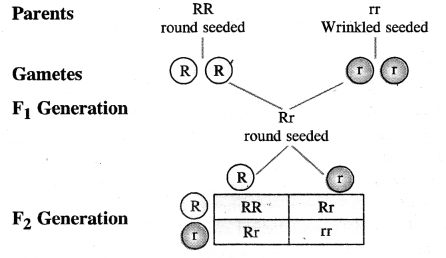
Phenotypic Ratio: 3 round seeded : 1 wrinkled seeded.
Genotypic Ratio: 1 pure round seeded (RR) : 2 hybrid round seeded (Rr). 1 wrinkled seeded (rr).
The reason for all rounded seeds in F1 generation and 75 % rounded seeds in F2 generation is the inability of recessive trait of wrinkled seeds to express itself in the presence of dominant trait of round seesds.
(b) TT and tt (height), YY and yy (seed colour).
Question 59.
“A trait may be inherited but may not be expressed.” Justify this statement with the help of a suitable example. (CCE 2014, CBSE A.I. 2016, 2017)
Answer:
A cross between parents with pure dominant (say TT) and pure recessive (say tt) traits produces hybrids or F1 individuals with dominant trait only but on self fertilization the F2 generation comes to have both individuals with dominant and recessive traits in the ratio of 3:1. Obviously F1 individuals have received the recessive trait but the same is unable to express itself in the presence of dominant trait.
Question 60.
(a) Which type of organs are shown in the figure.
(b) Which type of origin and structure do these organs have ?
(CCE 2014)
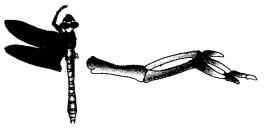
Answer:
(a) Wings of Dragon fly and wing of bird.
(b) Wings of Dragon fly are extensions of integument while wing of bird is modified fore limb. The two are analogous structures.
Question 61.
An organ like wing in birds is an advantage to the organism. Did it appear in different stages or was formed due to a single sudden change. (CCE 2014)
Answer:
Organs like wings appeared in different intermediate stages and not through sudden change. Wings were preceded by feathers in small extinct dinosaurs called dromaesaurs. They were also present on the fore limbs. The feathered fore limbs helped the small animals in longer jumps. It was followed by gliding and then flying.
There are two interbreeding groups of a population in a particular area.
Question 62.
In situation A, population groups reach each other, in B they cannot.
(a) In which situation new species will not be formed and why ?
(b) Which kind of fossils retain the minute details ? (CCE 2014)
Answer:
(a) In situation A, due to free flow of genes between population groups.
(b) Petrifications where silica and other minerals penetrate the dead bodies and replace their contents molecule by molecule.
Question 63.
Explain with an example for each, how the following provides evidences in favour of evolution in organisms :
(a) Homologous organs
(b) Analogous organs
(c) Fossils. (CCE 2015, CBSE Delhi 2017)
Answer:
(a) Homologous organs: Homologous organs have similar internal body plan and anatomy. Fore limbs of all tetrapods have pentadactyl structure being made of humerus, radioulna, carpals, metacarpals and phalanges. However, they perform different functions in different tetrapods like absorbing shock of jumping in Frog, creeping in lizard, flying in birds or grasping in humans. These organs clearly indicate a common ancestry from which different modifications occurred that suited them in their habitats.
(b) Analogous organs: Analogous organs, though quite different in basic structure and development have been modified or undergone evolution to form similar functional structures, e.g., wings of butterfly (outgrowths of integument) and bird (modification of fore limbs).
(c) Fossils: They are remains or impressions of past organisms that lie hurried in the rocks and other structures belonging to various ages.
Question 64.
Explain :
(a) Speciation
(b) Natural selection (CCE 2015)
Answer:
(a) Speciation: It is the formation of newer species from the pre-existing ones due to accumulation of variations through various processes like isolation, stoppage of gene flow, genetic drift, and natural selection that lead to inability to interbreed.
(b) Natural Selection: Natural selection is preferential survival and differential reproduction of individuals of a population which possess variations that provide better adaptability to the existing environment. In a beetle population of mostly red colour, a few green beetles appear due to variation. While red beetles are eaten by crows, the green beetles are spared. The number of green beetles will gradually rise while that of red beetles will decline and ultimately disappear. Here, natural selection is being exerted by crows resulting in a new type of beetle population.
In an experiment, Mendel obtained 1014 plants out of which 787 were having round seeds and 227 had wrinkled seeds in F2 generation.
Question 65.
(a) What is the approximate ratio obtained in F2 generation ?
(b) Under which law do you find this ratio ?
(c) Why is this law so called ? (CCE 2015)
Answer:
(a) 3:1
(b) Law of segregation or principle of purity of gametes.
(c) Law of segregation is known so because the two factors or alleles of a character separate and pass to different gametes at the time of gametogenesis. As a result a gamete contains only one factor of a character. Homologous organs are different from analogous organs.
Question 66.
(a) Mention the two characteristics that decides about analogy and homology between two organs.
(b) On what basis is the classification of organisms into prokaryotes and eukaryotes done ? (CCE 2015)
Answer:
(a)
- Origin of the organ and its basic plan of structure.
- Analogous organs have similar functions and appearance. Homologous organs have different functions and appearance. The same are caused by evolution.
(b) Presence (eukaryotes) and absence (prokaryotes) of nuclear organisation.
Question 67.
Who was Gregor John Mendel ? What was his contribution to heredity ? (CCE 2015)
Answer:
Gregor Johann Mendel (1822 – 1884) is known as father of genetics as he discovered the mechanism of transmission of characters from one generation to the next. Mendel was born in Silician, a village in Heinzendorf (now part of Czech Republic) on July 22, 1822 to a farmer’s family. He was a brilliant student. After graduation, Mendel joined monastery at Brunn (then in Austria, now Brno in Czechoslovakia) in 1843 at the age of 21. He became priest in 1847. In 1851, Mendel went to University of Viena for study of Science and Mathematics. He returned to Brunn as substitute teacher (because he failed to clear his examination for teaching certificate). Mendel served as teacher for 14 years. Later he was made abbot of the monastery.
Humans have cultivated the wild cabbage for thousands of years. Then by artificially selecting the traits a variety of plants have been obtained. Write the characteristics feature of each of the following :
Question 68.
(a) Kohlrabi, Cauliflower, Broccoli, Cabbage.
(b) Since how long cabbage has been cultivated for ? (CCE 2015)
Answer:
(a)
- Kohlrabi: Swollen stem.
- Cauliflower: Sterile condensed inflorescence.
- Broccoli: Green immature flowers in bunches.
- Cabbage: Terminal enlarged bud.
(b) Cabbage has been in cultivation for over 2000 years.
Question 69.
Explain the formation of sub-population in neighbourhood by taking the example of beetle. (CCE 2015)
Answer:
Beetles have a tendency to remain restricted to a few nearby bushes on which they live, feed and reproduce. In a large population of beetles spread over a mountain range, a number of separate segments of population will occur depending upon the spread of groves of bushes. As there is little gene flow among separated segments of population, they develop and accumulate their own variations and form sub-populations. A sub-population can further evolve into reproductively isolated population if natural barrier develops between it and other sub-populations, e.g., a glacier, water body, mountain cut.
Question 70.
(a) Planaria, insects, octopus and vertebrates all have eyes. Can we group eyes of these animals together to establish a common evolutionary origin ? Justify your answer.
(b) “Birds have evolved from reptiles”. State evidence to prove the statement. (CCE 2015)
Answer:
Answer:
(a) Eyes of the above four types of animals are structurally quite different. They are analogous structures.
(b) Cleidoic eggs and scales are found in both reptiles and birds, indicating their close relationship. Birds have evolved from reptiles as they have developed completely four-chambered heart (instead of incompletely four-chambered heart of reptiles), a toothless beak, fore-arms modified into wings and covering of feathers (as found in dromaesaurs).
Question 71.
At what stage is sex determined in human beings ?
Answer:
At the time of conception.
In human beings sex is determined by a pair of chromosomes called sex chromosomes. Sex complement of a female is XX while that of a male is XY. The complement is formed at the time of fertilization of the ovum by the sperm, i.e. conception. The ovum is always of one type, 22 + X. Sperms are of two types, gynosperms (22 + X) and androsperms (22 + Y). Fusion of an androsperm (22 + Y) with an egg (22 + X) produces a zygote (44 + XY) that will develop into male baby. Fertilization of an ovum (22 + X) with a gynosperm (22 + X) will form a zygote (44 + XX) that grows into a female baby. Sex of the child cannot be changed afterwards by any method. It is determined at the time of conception.
Question 72.
What will happen if both the characters present in F1 generation pass together in F2 generation ? (CCE 2015)
Answer:
They will remain linked together. There will be no recombination. The F2 phenotypic ratio will be 3 : 1 as in monohybrid cross.
Question 73.
A child questioned his teacher that why do organisms resemble their parents more as compared to grand parents. In which way will teacher explain to the child ? (CCE 2015)
Answer:
A child receives two chromosomes of each type, one from each parent (50 : 50). These chromosomes have been inherited from only one of the two paternal grand parents and one of the two maternal grand parents. Hence, resemblance with grand parents will be lesser than resemblance with immediate parents.
Question 74.
A boy of 15 years has attached ear lobes and weight of 65 kg. Which of these is an acquired character and which is inherited ? Give reason for your choice.
Answer:
Attached Ear Lobes. Inherited character. Body Weight. Acquired character. There is no effect of environment on attached ear lobe while acquired character of weight can vary. Inherited trait is obtained from parents and is passed on to next generation. Acquired trait develops during life time of the individual. It is neither inherited nor passed on to next generation.
Question 75.
Rohit will be out of station for a week. He gave his aquarium to Raju, a friend in the neighbourhood for that
(a) Why did Rohit do that ?
(b) What does Rohit expect from Raju ?
(c) What will happen to the aquarium if left for a week unattended ?
(d) Why was Rohit keen on leaving the aquarium with his friend ? ( CCE 2015)
Answer:
(a) So, that the aquarium is looked after.
(b) To feed the fishes, change water and keep the instrument for aeration working.
(c) The fish will die.
(d) Rohit had full faith in his freind’s sincerity.
Question 76.
(a) “Males are heterogametes”, Why ?
(b) Differentiate between inherited and acquired characters by giving two points. (CCE 2015)
Answer:
(a) Human males produce two types of sperms (22+X and 22+Y). Therefore, they are called heterogametic.
(b)
|
Acquired Traits |
Inherited Traits |
| 1. Development. The traits develop during life time of an individual.
2. Nature. They are somatic variations. 3. Cause. Acquired traits develop due to direct effect of environment, use and disuse and conscious efforts. 4. Fate. They die with the death of the individual. Ex. Muscular body of a wrestler. |
The traits are obtained from the parents.
They are genetic variations. The traits develop due to mutations and reshuffling of genetic material. They are passed on to the next generation. Ex. Fused and free ear lobes. |
Question 77.
In one of his experiments with Pea plants, Mendel observed that when a pure tall Pea plant is crossed with a pure dwarf Pea plant, in F, or first generation only tall plants appear,
(a) What happens to the trait of the dwarf plants in this case ?
(b) When the F1 generation plants were self fertilized, he observed that in the plants of second generation (F2) both tall and dwarf plants were present. Why it happened ? Explain briefly.
(CBSE Delhi 2016)
Answer:
A number of different types of variations develop in a population. All of them do not have survival value. However, some of them are pre-adaptations which can be beneficial under certain environmental conditions. For example, in a heat wave most of the bacteria will die but a few having pre-adaptation or variation to tolerate heat wave will survive and multiply. Actually selection of variants by different environmental factors constitutes the basis for evolution.
Question 78.
In a monohybrid cross between tall Pea plants (TT) and short Pea plants (tt), a scientist observed only tall Pea plants (Tt) in the F1 generation. However, on selfing the F1 generation Pea plants he obtained both tall and short plants in F2 generation. On the basis of above observations with other angiosperms also, can the scientist arrive at a law ? If yes, explain the law. If not, give justification for your answer. (CBSE Delhi 2016)
Answer:
Yes, The scientist would arrive at the law of dominance. The law states that when both the alleles of a character are present together in an individual, only one expresses its trait. It is called dominant trait. The other trait which remains suppressed though its allele is present is called recessive. This happens in F1 generation. However, due to segregation and chance’coming together of the two alleles, both the dominant and recessive traits appear in F2 generation.
Question 79.
List two differences in tabular form between dominant and recessive traits. What percentage/proportion of the plants in F2 generation/progeny were round in Mendel’s cross between round and wrinkled seeded Pea plants ? (CBSE Foreign 2016)
Answer:
Differences:
|
Dominant Factor or Allele |
Recessive Factor or Allele |
| 1. Expression: It is able to express its effect even in the presence of recessive factor. | Recessive factor is unable to express its effect in the presence of dominant factor. |
| 2. Protein: It produces an effective protein for expressing its effect. | It produces a defective or incomplete protein. |
| 3. Occurrence: Dominant trait appears in more members of the population. | Recessive trait appears in fevwer individuals. |
The trait of rounded seed is dominant over wrinkled seed. In F2 generation the rounded seed appears in 75% of the population as the phenotypic ratio is 3 : 1 duration.
Question 80.
List three factors that provide evidence in favour of evolution in organisms and state the role of each in brief. (CBSE Foreign 2016, 2017)
Answer:
- Homologous organs: They are organs with similar internal structure and similar origin which have bacome modified or evolved to perform different fractions, e.g., fore limbs used for flying in birds, swimming in whale and grasping in humans.
- Analogous Organs: They are organs which have different internal structure and different origin but have evolved to perform similar function, e.g, wings in birds and moth.
- Fossils: They are remains or impressions of past organisms. Fossils indicate that different organisms lived in different periods and that organisms of one age have evolved from organisms of previous age.
Question 81.
Explain Mendel’s experiment with peas on inheritance of characters considering only one visible contrasting character. (CBSE Foreign 2016)
Answer:
Mendel crossed Garden Pea plants having contrasting visible traits, e.g., tall and dwarf, violet and white flowered.
In F1 generation there were no halfway characteristics. A cross between pure tall and pure dwarf plants yielded only tall plants in F1 generation. There were no medium height plants. When F1 plants were self bred, the F2 plants were not all tall plants. Instead, both tall and dwarf plants appeared in ratio of 3 : 1. It means that the trait for dwarfness was present in F1 generation but was not expressed while the trait for tallness expressed itself.
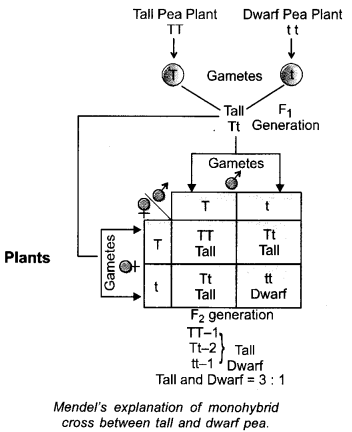
The trait of tallness which expresses itself in the presence of its contrasting form is called dominant. The other trait of dwarfness which is unable to express its effect in the presence of its contrasting trait is known as recessive.
Question 82.
“Evolution and classification of organisms are interlinked”. Give reasons to justify this statement.
(CBSE A.I. 2017)
Answer:
- Classification divides organisms into groups and subgroups on the basis of their similarities and dissimilarities. In a large group, all the organisms possess some similar basic or ancestral characters. In its subgroups, each subgroup has some common derived characters. They are different from other subgroups. The derived characters have developed only through evolution.
- Classification helps in tracing the evolutionary relationships amongst organisms by studying the basic and derived traits.
- The more characters two species have in common, more closely are they related, e.g., leopard and tiger.
Long Answer Questions (5 Marks each)
Question 1.
- What is genetics ?
- Give the common name of the plant on which Mendel performed his experiments.
- What for did Mendel use the term factors and what are these factors called now ?
- What are genes ? Where are the genes located ? (CBSE Delhi 2006)
Answer:
- Genetics: It is the branch of biology that deals with the study of heredity and variations.
- Garden or Edible Pea.
- Factors: They are particulate inheritable entities which control the expression of traits of a character, e.g, T for tallness, t for dwarfness. The factors are now called genes.
- Genes: They are units of inheritance that take part in expression of particular characters. Genes are located over the chromosomes as linear segments.
Question 2.
(i) What are chromosomes ? Where are they seated ? (CBSE Foreign 2008)
(ii) What is a sex chromosome ?
(iii) Explain the mechanism of sex determination in human beings.
Answer:
(i) In case of asexually reproducing organisms, there is no gametogenesis and fertilization. Chance separation and chance pairing of genes and their chromosomes are absent. Therefore, asexually developed individual carries the same genes and their chromosomes as are present in its parent.
(ii) Allosomes (Gk. alios— other, soma—boay) or sex chromosomes are those chromosomes which determine the sex of the individual in unisexual organisms. Human beings have 23 pairs of chromosomes.
(iii) Establishment of male and female individuals through differential development of their sex organs is called sex determination. In some organisms sex is determined by environmental conditions. In others including human beings, it is determined genetically.
Environmental Determination of Sex.
- Crepidula (marine mollusc) and Bonellia (marine worm) develop into females if growing alone. In the company of a female, they develop into males.
- In turtle, Chrysema picta an incubation temperature above 33°C produces females while a temperature below 28°C produces only males.
- In lizard, Agama agama, high incubation temperature produces male offspring.
- Annelid Ophryotrocha is male in young state and female later on. Snails are also known to change sex.
Question 3.
(a) What is geographical isolation ?
(b) Illustrate formation of a species with the help of an example where individuals are very different from each other and are capable of reproduction among themselves. (CCE 2011)
Answer:
(a) Geographical Isolation. Prevention of mating between breeding groups due to geographical or physical barriers (e.g., Valley, Mountain, Water body) is called geographical isolation. The isolated populations develop different variations and changes in physiology and behaviour to form new species.
(b) Over 160 breeds of dogs have come up due to selective breeding and artificial selection. Similarly, there are about 800 breeds of cattle. They differ in size, height, features, behaviour, colour and other traits. However, all dogs belong to one species of Canis familiaris while all cattle belong to one species of Bos indiens. Despite their structural and behaviour differences all the breeds belonging to the same species can interbreed and produce fertile offspring. However, if interbreeding is prevented by spatial isolation these different breeds can develop reproductive isolation and form new species, e.g., Porto Santo rabbits, Galapogos finches.
Question 4.
Name any five vegetables generated from a common ancestor through artificial selection rather than natural selection. Also mention the features for which each vegetable is selected. (CCE 2011)
Answer:
Artificial Selection in Wild Cabbage. The plant has been under cultivation for more than 2000 years as food plant. Artificial selection carried out at different times have given rise to following vegetables.
- Closer leaves provided more value to the food plant. Artificial selection of variants in this direction has given rise to a large terminal bud being used as vegetable. It is cabbage.
- Selection of larger leaves for enhancing food value of the plant has produced the leafy vegetable of kale.
- Swollen stem parts could increase food value. It resulted in selection of swollen stem in Kohlrabi.
- Brussel’s Sprout. The large axillary buds are used as a vegetable.
- The plant with immature green flowers has been selected as a vegetable.
- Here selection has been for a cluster of sterile flowers.
Question 5.
a) Define evolution.
(b) Mention any four ways by which individuals with -a particular trait may increase in a population. (CCE 2013)
Answer:
(a) Evolution: It is the formation of newer types of organisms from the pre-existing ones through modification, i. e., descent with change or modification.
(b) Fossils Indicate Evolution
- Different types of organisms appeared in different ages. Many of them have later on disappeared. Some gave rise to other organisms while a few are persisting even now.
- Early forms were simple. Most of the later forms became more and more complex.
- Fossils of different ages indicates the path of evolution,
- Some fossils have characteristics intermediate between two groups, e.g., Archaeopteryx between reptiles and birds. They indicate the path of evolution.
- Phylogeny of some organisms has been worked out with the help of fossils e.g., Horse.
Question 6.
(i) What is meant by traits of an individual ?
(ii) Explain inherited trait and acquired trait.
(iii) Define spéciation. List the factors which could lead to rise of new species. (CCE 2013)
Answer:
(i) Traits: They are distinguishable expressions of well defined morphological or physiological features of an individual, e.g., tall and dwarf in height.
(ii) Inherited Trait: It is genetically controlled trait which is passed from parents to the offspring, generation after generation, .e.g, fused or free ear lobe.
Acquired Trait: It is variation which an individual develops during its life time due to effect of environmental factors, use and disuse of organs and conscious efforts, e.g., education, music.
(iii) Speciation: It is the formation of newer species from the pre-existing ones through modifications and reproductive isolation.
Factors:
- Absence of gene flow amongst sub-populations due to the presence of physical barriers, long distance, differences in habitats, environmental and climatic conditions.
- Accumulation of different variations in the different sub-populations of the species.
- Natural selection of particular traits in a particular environment.
- Genetic Drift. Separation of a small population, changes in its allele frequency, new mutations and adaptations to new habitat.
- Reproductive Isolation. Accumulation of different variations and genetic drift result in absence of interbreeding in the previous subpopulations of a species. This results in the formation of new species. e.g., Finches of Galapogos islands.
Question 7.
(a) Distinguish between acquired traits and inherited traits.
(b) What is speciation ? What are the factors responsible for it ? (CCE 2013)
Answer:
(a)
|
Acquired Traits |
Inherited Traits |
| 1. Development. The traits develop during life time of an individual.
2. Nature. They are somatic variations. 3. Cause. Acquired traits develop due to direct effect of environment, use and disuse and conscious efforts. 4. Fate. They die with the death of the individual. Ex. Muscular body of a wrestler. |
The traits are obtained from the parents.
They are genetic variations. The traits develop due to mutations and reshuffling of genetic material. They are passed on to the next generation. Ex. Fused and free ear lobes. |
(b) Speciation: It is the formation of newer species from the pre-existing ones through modifications and reproductive isolation.
Factors:
- Absence of gene flow amongst sub-populations due to the presence of physical barriers, long distance, differences in habitats, environmental and climatic conditions.
- Accumulation of different variations in the different sub-populations of the species.
- Natural selection of particular traits in a particular environment.
- Genetic Drift. Separation of a small population, changes in its allele frequency, new mutations and adaptations to new habitat.
- Reproductive Isolation. Accumulation of different variations and genetic drift result in absence of interbreeding in the previous subpopulations of a species. This results in the formation of new species. e.g., Finches of Galapogos islands.
Question 8.
What are fossils ? How are they formed ? Explain how fossils support evolution. (CCE 2013)
Answer:
Fossils: They are remains or impressions of past organisms that lie hurried in the rocks and other structures belonging to various ages.
Formation: Fossil formation or fossilisation occurs in bogs, lava and in sediments at the bottom of deep waters where there is little oxygen and rate of decay is slow or absent. Dead bodies settle down at the bottom which get covered by sand and silt. Under acidic conditions some silica can penetrate cells of dead organism and form perfect fossil. In other cases, softer parts decay ultimately and hard parts persist as fossils. Impressions, moulds and casts develop if all parts decay after some time. The sedimented mud and
sand harden to form sedimentary rock which may come to the surface due to upheavals in earth. This exposes the fossils.
Fossils indicate Evolution:
- Different types of organisms appeared in different ages. Many of them have later on disappeared. Some gave rise to other organisms while a few are persisting even now.
- Early forms were simple. Most of the later forms became more and more complex.
- Fossils of different ages indicates the path of evolution,
- Some fossils have characteristics intermediate between two groups, e.g., Archaeopteryx between reptiles and birds. They indicate the path of evolution.
- Phylogeny of some organisms has been worked out with the help of fossils e.g., Horse.
Question 9.
Define the following :
- Gene
- Genetic drift
- Recessive trait
- Evolution
- Genetics. (CCE 2014)
Answer:
- Gene: They are units of inheritance that take part in expression of particular characters. Genes are located over the chromosomes as linear segments.
- Genetic Drift: It is random change in gene frequency in small isolated population owing to factors other than natural selection that results in fixation of certain alleles and elimination of some others.
- Recessive Trait: It is a trait which is unable to express its effect in the presence of its contrasting trait.
- Evolution: It is the formation of newer types of organisms from the pre-existing ones through modification, i. e., descent with change or modification.
- Genetics: It is the branch of biology that deals with the study of heredity and variations.
Question 10.
In organisms, some changes pertain to body cells and are not inherited whereas some changes pertain to germ * cells and are inherited.
(a) Name the two types of variations respectively.
(b) Explain the two ways by which individuals with a particular trait may increase in a population.
(CCE 2014)
Answer:
(a) Body Cells: Somatic variations. They die with the death of the individual.
Germ Cells: Germinal variations. They are passed on to the next generation and are, therefore, inherited.
(b)
|
Acquired Traits |
Inherited Traits |
| 1. Development. The traits develop during life time of an individual.
2. Nature. They are somatic variations. 3. Cause. Acquired traits develop due to direct effect of environment, use and disuse and conscious efforts. 4. Fate. They die with the death of the individual. Ex. Muscular body of a wrestler. |
The traits are obtained from the parents.
They are genetic variations. The traits develop due to mutations and reshuffling of genetic material. They are passed on to the next generation. Ex. Fused and free ear lobes. |
Question 11.
How do Mendel’s experiments show that the
(a) Traits may be dominant or recessive,
(b) Traits are inherited independently.
(CCE 2015, CBSE Delhi 2017)
Answer:
(a) Dominant and recessive traits can be proved by monohybrid cross. A cross between pure tall Pea plant with a pure dwarf Pea plant yields only tall plants in F1 generation. Self pollination in F1 plants results in appearance of both tall and dwarf plants in the ratio of 3 : 1. Absence of dwarf plants in F1 generation and their reappearance in F2 generation in 25% population shows that the trait for dwarfness is recessive. It does not express its effect in the presence of allele for tallness. The factor for tallness is dominant over the factor for dwarfness.
(b) That traits are inherited independently can be proved by a dihybrid cross like RRYY and rryy. In F1 generation all the plants were having round seeds with yellow colour. On self pollination, the F2 generation has 4 types of plants—round yellow (9), round green (3), wrinkled yellow (3) and wrinkled green (1). While round yellow and wrinkled green are parental types, the other two (round green and wrinkled yellow) are recombinants. Recombinants can appear only if the traits are inherited independently.
Question 12.
What are fossils ? How are they formed ? Describe in brief two methods of determining the age of fossils. State any one role of fossils in the study of process of evolution. (CCE 2015, CBSE Foreign 2016, 2017)
Answer:
Fossils: They are remains or impressions of past organisms that lie hurried in the rocks and other structures belonging to various ages.
Formation: Fossil formation or fossilisation occurs in bogs, lava and in sediments at the bottom of deep waters where there is little oxygen and rate of decay is slow or absent. Dead bodies settle down at the bottom which get covered by sand and silt. Under acidic conditions some silica can penetrate cells of dead organism and form perfect fossil. In other cases, softer parts decay ultimately and hard parts persist as fossils. Impressions, moulds and casts develop if all parts decay after some time. The sedimented mud and
sand harden to form sedimentary rock which may come to the surface due to upheavals in earth. This exposes the fossils.
Age of Fossils: Age of Fossil Organisms,
- Relative Dating. Fossils closer to the surface are more recent than the ones present midway which in turn are more recent than the ones present in deeper layers of rocks.
- Radioactive or Absolute Dating. Fossil or piece of fossil containing rock is analysed for radioactive decay
(uranium —> lead, radioactive Potassium —> argon, l4C content) to calculae the age.
Role of Fossils in Study of Evolution:
- Different types of organisms appeared in different ages. Many of them have later on disappeared. Some gave rise to other organisms while a few are persisting even now.
- Early forms were simple. Most of the later forms became more and more complex.
- Fossils of different ages indicates the path of evolution,
- Some fossils have characteristics intermediate between two groups, e.g., Archaeopteryx between reptiles and birds. They indicate the path of evolution.
- Phylogeny of some organisms has been worked out with the help of fossils e.g., Horse.
Question 13.
Give differences :
(a) Heredity and variations
(b) Dominant and recessive traits,
(c) Natural and artificial selection. (CCE 2015)
Answer:
(a) Differences Between Heredity and Variations
|
Heredity |
Variations |
| 1. Nature. It is the transmission of characters from parents to offspring.
2. Cause. Heredity occurs due to passage of chromosomes or DNA from parents to offspring. 3. Use. It keeps the identity of population intact. |
They are differences in combination of traits amongst members of a species.
They are caused by reshuffling of genes, mutations as well as environment. They help in adaptations to changing environment as well as natural selection. |
(b) Differences Between Dominant and Recessive Factors
|
Dominant Factor or Allele |
Recessive Factor or Allele |
| 1. Expression. It is able to express its effect even in the presence of recessive factor. | Recessive factor is unable to express its effect in the presence of dominant factor. |
| 2. Protein. It produces an effective protein for expressing its effect. | It produces a defective or incomplete protein. |
| 3. Occurrence. Dominant trait appears in more members of the population. | Recessive trait appears in fevwer individuals. |
(c) Differences Between Natural Selection and Artificial Selection
|
Natural Selection |
Artificial Selection |
| 1. Organisms. It operates over all organisms.
2. Agency. It is carried out by nature. 3. Traits. The selected traits have adaptive value. 4. Care. Products of natural selection do not require human care or protection. 5. Rapidity. It is a slow process. |
It operates on some selected organisms.
It is carried out by humans. The selected traits are important to human beings. Organisms undergoing artificial selection require human protection. It is a faster process. |
Question 14.
(a) Why do we say that homozygous plants produce pure progeny ?
(b) Define heterozygous.
(c) Explain how the process of speciation takes place. (CCE 2015)
Answer:
(a) Homozygous Plants: They possess identical alleles of a character (e.g., IT ). All their gametes come to have the same type of allele (e.g., T) so that fusion of two such gametes produce the genetic make up (TT) similar to the parent. This will continue for generations so that such plants are called pure lines.
(b) Heterozygous: It is an individual having both the contrasting alleles of a character (e.g., Tt). Heterozygous individuals is called hybrid.
(c) Speciation: It is formation of newer species from pre-existing ones due to reproductive isolation of segments of their population. Scpeciation is of two types, sympatric and allopatric.
Sympatric speciation occurs in the same area due to mutations in a section of population that result in its reproductive isolation from the rest of population.
Allopatric speciation: It occurs in sub-population occurring in different and mutually exclusive areas of distribution due to physical barriers (e.g., valley, mountain, water body), ends of a long range and genetic drift. They accumulate different variations and become transformed into different species.
Question 15.
Given here is a schematic diagram showing Mendel’s experiment on pea plants with yellow round and green wrinkled seeds. Answer the following questions :
(a) Complete the diagram by filling numbers 1-6.
(b) Write the phenotypes of F1 progeny,
(c) Name the phenotypes produced in F2 progeny upon self pollination of F1 progeny. (CCE 2015)
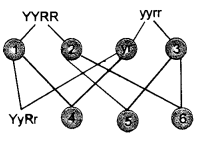
Answer:
(a)
- 1- YR,
- 2-YR,
- 3-yr,
- 4-YyRr,
- 5-YyRr,
- 6-YyRr.
(b) Yellow round seeded.
(c) Yellow round seeded 3 : Green wrinkled seeded 1.
Question 16.
(a) How many pairs of chromosomes are present in human beings ? Out of these how many are sex chromosomes ? How many types of sex chromosomes are found in human beings ?
(b) “The sex of a new born child is a matter of chance and none of the parents may be considered responsible for it.” Draw a flow chart showing determination of sex of new born to justify this statement. (CCE 2015)
Answer:
(a) 23 pairs. Out of them one pair are sex chromosomes or allosomes. In females, both the sex chromosomes are similar and are called XX. In males, the two sex chromosomes are different, X and Y.
(b) Sex of the child is determined by the gametes that fuse to form zygote which later grows into offspring. Human females (44 + XX) produce only one type of ova (22 + X). Human males (44 + XY) form two types of sperms, androsperms (22 + Y) and gynosperms (22 + X). Both are formed in equal number. It is a chance factor whether an androsperm or a gynosperm fuses with egg to form 44 + XY or 44 + XX child. A child that obtains an X-chromosome from father will be girl and the one who inherits a Y-chromosome will be boy.
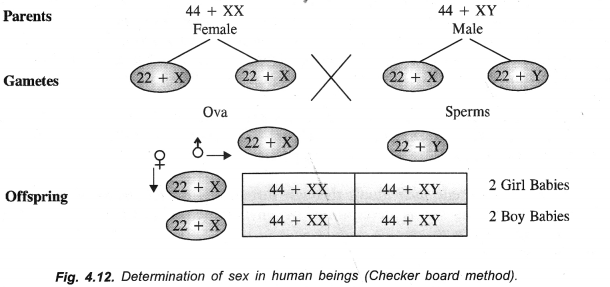
Question 17.
(a) Observe the ears of students of your class. Which variations do you observe related to ear ? What do you conclude ?
(b) Why did Mendel choose Pea plant for his expeirments ? Give 3 reasons. (CCE 2015)
Answer:
(a) Ear lobes: Attached and Free Ear Lobes
Observe the lower part of pinna or ear lobe of your class mates. Find out that there are two types of ear lobes, free (hanging separately) and attached (non-hanging). Out of 50 students, the students with attached ear lobes are fewer, say 8. The remaining students (42 here) have free ear lobes. Calculate the percentage of free ear lobes and attached ear lobes.
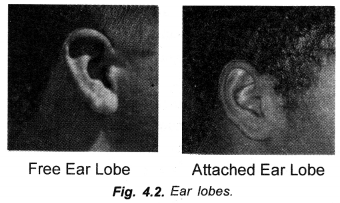

Now find out the ear lobes of the parents of your class mates. Attached ear lobes often occur in cases where one of the two parents of children having attached ear lobes. Free lobes always oscur in those cases where one or both the parents have free lobes. This is possible only when the trait of ear lobe is represented in an individual by two factors or alleles, E and e. Persons with free ear lobes have EE and Ee. Persons with attached ear lobes have ee. The two alleles separate at the time of gametogenesis, so that a sperm or egg has only one allele £ or e but not both. The two alleles come together during fertilization.
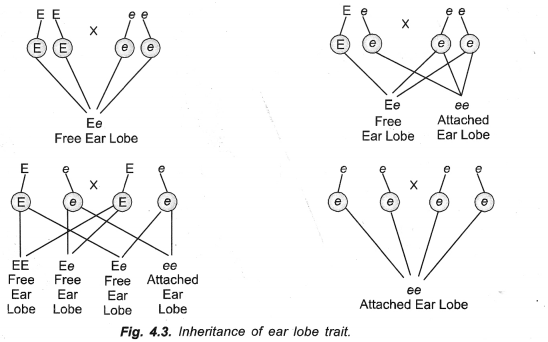
(b) Mendel’s Experimental Material:
Mendel chose Garden Pea or Edible Pea (Pisum sativum) as his experimental material because of
- Easy availability of detectable contrasting traits of several characters,
- Flower structure normally allows self fertilization but cross fertilization can also be carried out easily.
- Annual nature of the plant,
- Formation of a large number of seeds by each plant,
- Requirement of little care except at the time of cross breeding.
Mendel selected seven visible characters, each with two contrasting traits (Figure 4.5). They were given symbols, dominant with capital alphabet symbol (e.gtallness T) while the recessive were given small alphabet symbol (e.g., dwarfness t). All the plants were pure breeding. They formed the parent (P) generation.
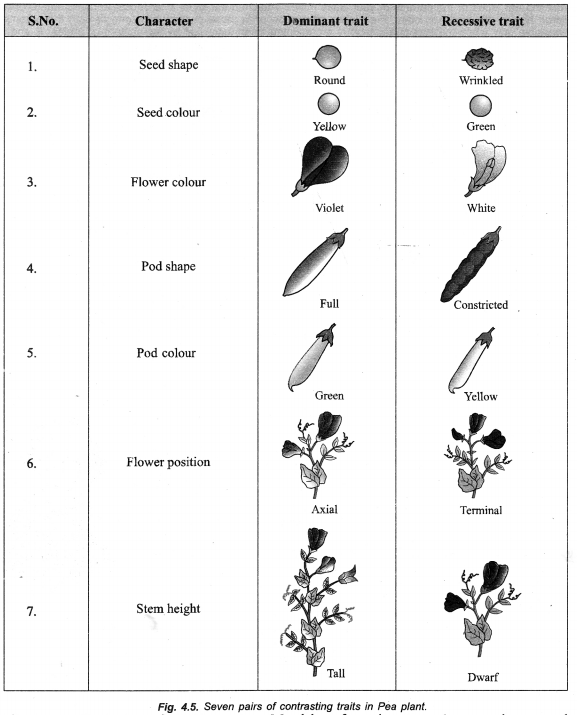
Question 18.
(a) “Evolution has occurred in stages”. Justify the statement.
(b) Differentiate between eye and eyespots. Which animal possesses eye spots ? (CCE 2015)
Answer:
(a) Evolution does not proceed continuously in one direction. A number of stages occur with each stage giving rise to one or more branches. Both humans and chimpanzee are closely related but neither of them has given rise to the other. Rather they have evolved from a common ancestor which neither gave rise to modern day chimpanzee nor modern human in one step. Instead, descendants of this ancestor gave rise to various forms. One of them gave rise to chimpanzee. Another gave rise to humans. A third one formed great apes.
(b) Eye is an organ of the body that forms images of the surroundings. Eye spot is a light sensitive area of the body surface where images are not formed but sensitivity about the surrounding is perceived, e.g., Planaria.
Question 19.
Give reason for the following :
(a) Traits acquired during lifetime of an individual are not inherited.
(b) All humans belong to a single species.
(c) Variations keep on accumulating during reproduction and do not disappear in next generation.
(CCE 2015)
Answer:
(a) Acquired variations influence only the somatic cells. They die with the death of the individual.
(b) Delimitation of a species is based on the presence of a common gene pool, free inbreeding and reproductive isolation. Differences in size, colour and looks are based on preponderance of specific alleles and their interactions with the environment. All human beings, despite presence of different races, belong to same species (Homo sapiens) because they share the same gene pool, can marry amongst themselves and produce fertile offspring.
(c) They are inherited variations. Most of them are produced during reproduction due to reshuffling of chromosomes, recombinations, and some due to mutations. Inherited variations are passed on to next generation.
Question 20.
What is meant by spéciation ? List four factors that could lead to spéciation. Which of these cannot be a major factor in the spéciation of self-pollinating plant species. Give reason to justify your answer.
(CBSE Delhi 2016)
Answer:
Speciation: It is the formation of newer species from the pre-existing ones through modifications and reproductive isolation.
Factors:
- Absence of gene flow amongst sub-populations due to the presence of physical barriers, long distance, differences in habitats, environmental and climatic conditions.
- Accumulation of different variations in the different sub-populations of the species.
- Natural selection of particular traits in a particular environment.
- Genetic Drift. Separation of a small population, changes in its allele frequency, new mutations and adaptations to new habitat.
- Reproductive Isolation. Accumulation of different variations and genetic drift result in absence of interbreeding in the previous subpopulations of a species. This results in the formation of new species. e.g., Finches of Galapogos islands.
Self Pollinating Plants: Geographical isolation has little role in spéciation of self pollinating plant species because there is already no gene flow among members of the species. Pea or Wheat which is self pollinated (due to pollination in bud condition) is not affected by any type of isolation. However, self pollinated plants can accumulate variations due to mutations and other factors and form new species.
Question 21.
(a) Why did Mendel choose Garden Pea for his experiments ? Write two reasons,
(b) List two contrasting visible characters of Garden Pea, Mendel used for his experiments
(c) Explain in brief how Mendel interpreted his results to show that the traits may be dominant or recessive. (CBSE Foreign 2016)
Answer:
(a) Garden Pea As Experimental Material:
- Availability of true breeding varieties,
- Both self and cross pollination are possible.
- Small size, short life cycle, easy to grow and maintain.
(b) Contrasting Traits:
- Height: Tall and dwarf,
- Seed Shape: Round and wrinkled
- Seed Colour.
- Yellow and green.
(c) Interpretation by Mendel: Mendel crossed Garden Pea plants having contrasting visible traits, e.g., tall and dwarf, violet and white flowered.
In F1 generation there were no halfway characteristics. A cross between pure tall and pure dwarf plants yielded only tall plants in F1 generation. There were no medium height plants. When F1 plants were self bred, the F2 plants were not all tall plants. Instead, both tall and dwarf plants appeared in ratio of 3 : 1. It means that the trait for dwarfness was present in F1 generation but was not expressed while the trait for tallness expressed itself.
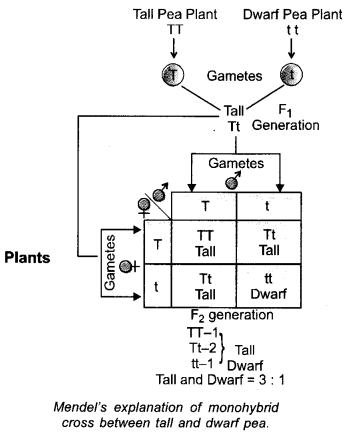
The trait of tallness which expresses itself in the presence of its contrasting form is called dominant. The other trait of dwarfness which is unable to express its effect in the presence of its contrasting trait is known as recessive.
Question 22.
Define evolution. How does it occur ? Describe how fossils provide us evidence in support of evolution.
(CBSE A.I. 2016)
Answer:
Evolution: It is the formation of newer types of organisms from the pre-existing ones through modifications or accumulation of variations.
Mechanism:
- Absence of gene flow amongst sub-populations due to the presence of physical barriers, long distance, differences in habitats, environmental and climatic conditions.
- Accumulation of different variations in the different sub-populations of the species.
- Natural selection of particular traits in a particular environment.
- Genetic Drift. Separation of a small population, changes in its allele frequency, new mutations and adaptations to new habitat.
- Reproductive Isolation. Accumulation of different variations and genetic drift result in absence of interbreeding in the previous subpopulations of a species. This results in the formation of new species. e.g., Finches of Galapogos islands.
Fossils As Evidence of Evolution:
Fossils: They are remains or impressions of past organisms that lie hurried in the rocks and other structures belonging to various ages.
Fossils Indicate Evolution
- Different types of organisms appeared in different ages. Many of them have later on disappeared. Some gave rise to other organisms while a few are persisting even now.
- Early forms were simple. Most of the later forms became more and more complex.
- Fossils of different ages indicates the path of evolution,
- Some fossils have characteristics intermediate between two groups, e.g., Archaeopteryx between reptiles and birds. They indicate the path of evolution.
- Phylogeny of some organisms has been worked out with the help of fossils e.g., Horse.
Hope given Previous Year Question Papers for CBSE Class 10 Science Chapter 9 Heredity and Evolution are helpful to complete your science homework.
If you have any doubts, please comment below. Learn Insta try to provide online science tutoring for you.